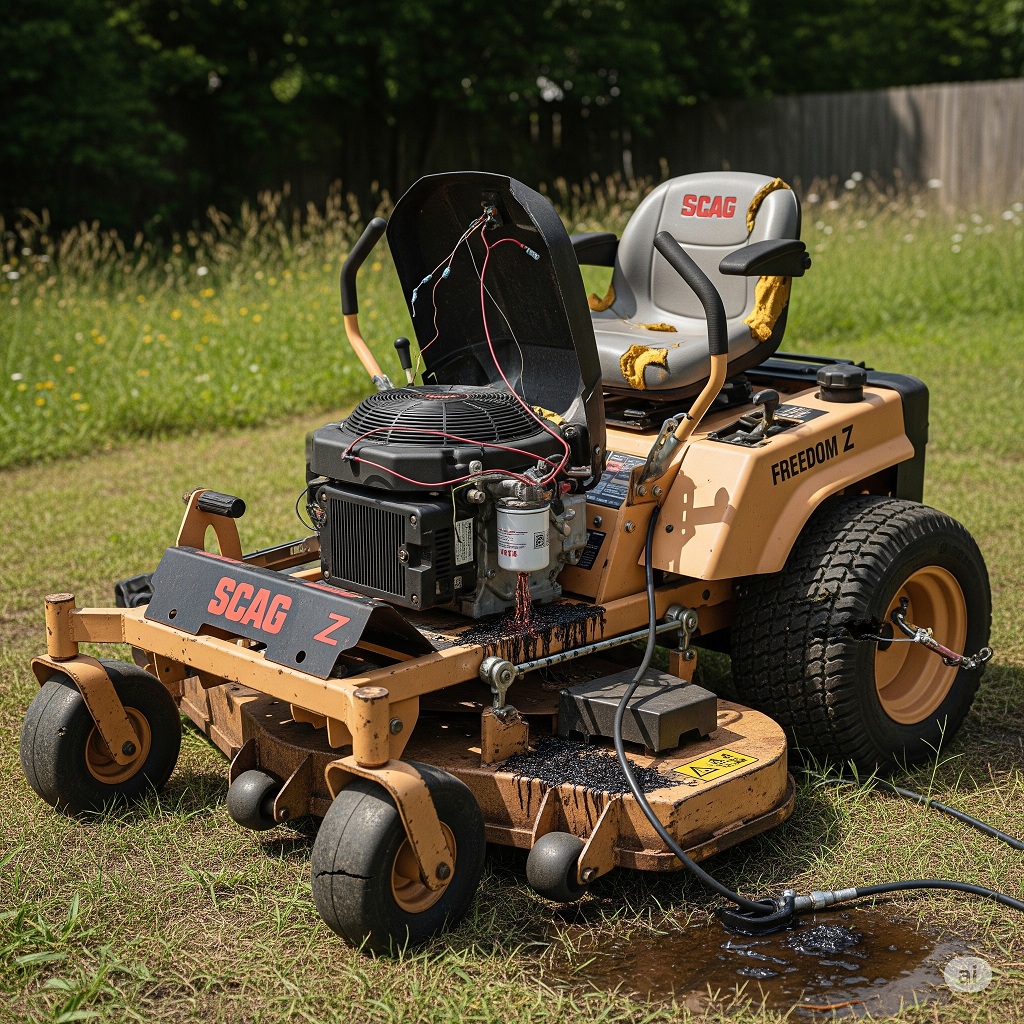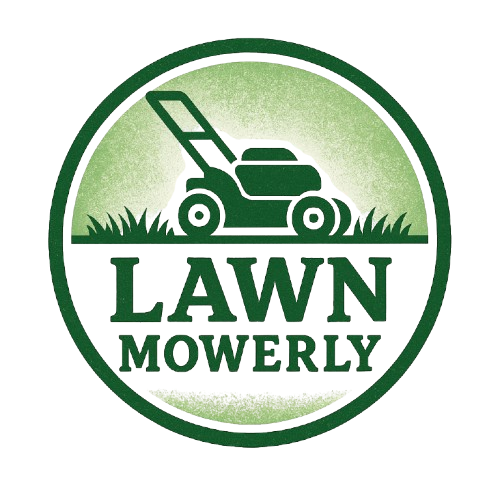
The Scag Freedom Z is a well-regarded residential and light commercial zero-turn mower known for its rugged build, Kawasaki engine options, and professional-grade mowing performance. Built with durability in mind, it bridges the gap between entry-level and full commercial units. However, no mower is entirely without fault, and the Freedom Z has its share of common issues that users may encounter over time.
In this guide, we’ll cover the most common problems with the Scag Freedom Z, their likely causes, and step-by-step solutions to keep your mower in top shape.
1. Starting Issues
Symptoms:
- Engine cranks but doesn’t start.
- Clicking noise, but no turnover.
- Mower only starts intermittently.
Common Causes:
- Weak battery or corroded terminals.
- Faulty safety switch (seat or PTO).
- Bad spark plug or fuel delivery problem.
- Failed ignition switch or starter solenoid.
Fixes:
- Check battery voltage (should be 12.4V+). Clean terminals and recharge or replace the battery.
- Bypass and test safety switches to identify faulty components.
- Clean or replace the spark plug (check gap: ~0.030″).
- Test starter solenoid and ignition switch with a multimeter.
- Check fuel line, filter, and carburetor for clogs or stale fuel.
Tip: If your mower sits for months, use a battery tender and fuel stabilizer during storage.
2. Hydrostatic Transmission Problems
Symptoms:
- Mower won’t move or is sluggish.
- Jerky or uneven movement.
- Loss of power when turning.
Common Causes:
- Low or contaminated hydraulic fluid.
- Air trapped in the system.
- Worn or loose drive belt.
- Leaking seals in transaxles.
Fixes:
- Check fluid level and top off with Scag-recommended hydraulic oil.
- Bleed the system by raising the rear wheels and cycling the levers forward and backward with the engine running.
- Replace worn or cracked drive belts and tension springs.
- Check for hydraulic leaks and repair or replace affected components.
Always follow the hydraulic service schedule; sealed units typically don’t require frequent changes but do require monitoring for leaks or performance loss.
3. Poor Cutting Quality
Symptoms:
- Uneven grass height.
- Streaking, scalping, or missed areas.
- Grass buildup under the deck.
Common Causes:
- Dull, bent, or mismatched blades.
- Unleveled mower deck.
- Incorrect blade type for terrain.
- Clogged deck or improper mowing speed.
Fixes:
- Sharpen or replace blades every 20-25 hours.
- Level the deck using a pitch gauge: side-to-side and front-to-back.
- Choose high-lift blades for bagging, mulching blades for finer cuts.
- Clean the underside of the deck and avoid mowing wet grass.
Deck pitch should ideally be 1/8″ lower in the front for optimal lift and discharge.
4. PTO (Blade Engagement) Problems
Symptoms:
- PTO switch doesn’t engage the blades.
- Blades stop under load.
- No sound or click when turning on PTO.
Common Causes:
- Faulty PTO switch.
- Failing PTO clutch.
- Low voltage to clutch or bad wiring.
- Worn deck belt or idler pulley.
Fixes:
- Test PTO switch and clutch coil (normal resistance: 2-4 ohms).
- Ensure battery and charging system provide adequate voltage under load.
- Replace a slipping deck belt with OEM replacements.
- Inspect and replace damaged pulleys or tensioners.
Weak batteries can cause blade disengagement, especially under thick grass load.
5. Engine Overheating or Loss of Power
Symptoms:
- Engine loses power after heating up.
- Mower shuts off or sputters.
- Reduced throttle response.
Common Causes:
- Clogged air filter or cooling fins.
- Old fuel or dirty carburetor.
- Faulty ignition coil.
- Low oil or incorrect viscosity.
Fixes:
- Clean/replace air filter and cooling fins around the engine.
- Drain old fuel and clean the carburetor jets.
- Test ignition coil for spark delivery.
- Use the correct oil type (usually SAE 10W-30 for Kawasaki engines in moderate climates).
Keep engine shrouds and cooling fins clean. Overheating can permanently damage the engine.
6. Electrical Issues
Symptoms:
- Dash doesn’t light up.
- Mower intermittently shuts off.
- Fuse frequently blows.
Common Causes:
- Loose or corroded ground wires.
- Blown fuse or bad safety switch.
- Faulty ignition switch or solenoid.
- Damaged wiring harness.
Fixes:
- Inspect all connections for corrosion and clean grounds.
- Replace blown fuses and test components one by one to isolate the issue.
- Test safety switches with a multimeter.
- Trace wiring for breaks or exposed wires causing shorts.
Use dielectric grease on connectors to prevent corrosion and moisture damage.
7. Deck Belt Slipping or Breaking
Symptoms:
- Deck belt slips off frequently.
- Loud squealing when mowing.
- Blades don’t spin or stop suddenly.
Common Causes:
- Misaligned or damaged pulleys.
- Belt worn, cracked, or too loose.
- Weak tension spring or bracket.
- Debris in the pulley area.
Fixes:
- Realign pulleys and ensure proper belt routing.
- Replace worn belts with Scag OEM belts.
- Tighten or replace the spring tensioner.
- Keep debris cleared from the belt and pulley area.
Replace both belt and pulley if both show signs of wear — mismatch can cause rapid failures.
8. Vibration or Noise During Operation
Symptoms:
- Shaking felt in seat or control levers.
- Noise increases when blades are on.
- Grinding, knocking, or rattling from deck area.
Common Causes:
- Bent or unbalanced blades.
- Worn or loose spindles.
- Missing anti-scalp wheels.
- Engine mounting bolts loose.
Fixes:
- Replace or balance mower blades.
- Tighten or replace blade spindles or bearings.
- Inspect and reinstall anti-scalp wheels correctly.
- Tighten engine and frame bolts.
Mower vibration shortens the life of components — address immediately to avoid chain failures.
9. Fuel System Problems
Symptoms:
- Engine surges or dies out.
- Runs only with choke partially on.
- Fuel leaks or gas smell under deck.
Common Causes:
- Clogged fuel filter or lines.
- Vacuum leak in fuel cap.
- Dirty carburetor or gummed jets.
- Faulty fuel solenoid.
Fixes:
- Replace the inline fuel filter regularly.
- Inspect fuel lines for cracks or air leaks.
- Clean or rebuild carburetor with cleaner and compressed air.
- Test fuel shutoff solenoid with a multimeter.
Ethanol fuel breaks down quickly — store with stabilizer or use ethanol-free fuel if possible.
10. Operator Comfort and Ergonomics
Issues:
- Stiff controls after long use.
- Uncomfortable seat for extended mowing.
- Hard deck height adjustment.
Fixes:
- Lubricate control arms and adjust tension bolts.
- Upgrade to a suspension seat or install a gel seat pad.
- Apply lubrication to the deck lift system and check for worn bushings.
The Freedom Z is built tough, but comfort upgrades can significantly reduce fatigue on long mowing days.
Preventative Maintenance Chart
| Task | Frequency |
|---|---|
| Change engine oil & filter | Every 50–100 hours |
| Sharpen mower blades | Every 25 hours |
| Clean air filter | Every 25 hours or as needed |
| Replace fuel filter | Every 100 hours |
| Grease mower fittings | Every 25 hours |
| Inspect belts/pulleys | Every 25–50 hours |
| Clean mower deck | After each use |
Is the Scag Freedom Z Worth It?
Despite these common issues, the Scag Freedom Z continues to be a top choice for property owners looking for a semi-commercial zero-turn mower. Most of its problems are relatively minor and are easy to fix with regular care and proper maintenance. The Freedom Z’s heavy-duty frame, reliable Kawasaki engines, and excellent cut quality make it a long-term performer if properly maintained.
FAQs
Q: What engine does the Scag Freedom Z use?
A: Most models are equipped with Kawasaki FR or FS series engines, known for reliability and performance.
Q: What is the top speed of the Scag Freedom Z?
A: It can reach up to 8 mph, making it efficient for large lawns.
Q: Can the Freedom Z mow hills?
A: Yes, it handles mild slopes well, but extreme hills should be avoided for safety.
Q: What deck sizes are available for the Freedom Z?
A: Decks range from 48” to 61” in the Freedom Z series.

I’m David man behind Lawn Mowerly; I’ve been dealing with lawnmowers and Tractors with my father since I was a kid. I know every make and model and what each one is capable of and love helping people find the perfect equipment for their needs.
